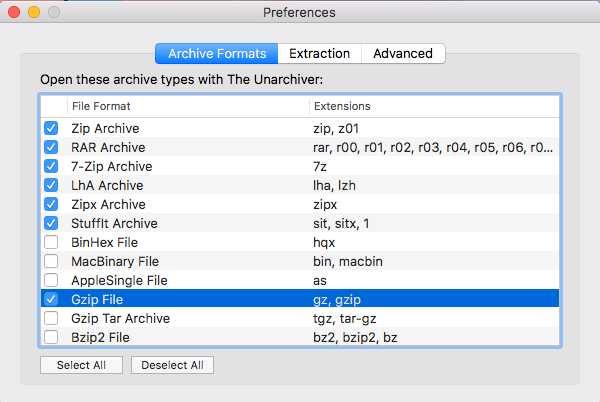
( atool can be configured not to use file.

In those cases when atool can't identify the format, file is used instead. Sometimes this is not possible - for instance rar archives usually have varying numeric file extensions. As atool invokes external programs to handle the archives, not all commands may be supported for a certain type of archives.Ītool identifies archives by their file extension. Supported Files Unarchiver One Mac supports all common archive formats. Drag and drop archive files to the Unarchiver One console to easily browse contents. Quickly extract files to the current folder by just right-clicking the compressed file. The other commands provided are apack (to create archives), als (to list files in archives), and acat (to extract files to standard out). Extract archive files to your preferred destination folder. aunpack also prevents local files from being overwritten by mistake. If there was only a single file in the archive, that file is moved to the original directory. Did you ever extract files from an archive, not checking whether the files were located in a subdirectory or in the top directory of the archive, resulting in files scattered all over the place? aunpack overcomes this problem by first extracting to a new directory. The main command is aunpack which extracts files from an archive. cpioĪtool is a script for managing file archives of various types (tar, tar+gzip, zip etc).

Unlike Stuffit Expander, which is also quite popular, The Unarchiver lets you extract files without regards to file permissions, whereas Stuffit Expander can sometimes fail you if the archive was not compressed properly.
#Make the unarchiver preferences for mac os#
I renamed the file to 'unarchiver.exeNOTHANKS' - and my system is healthy and back to normal. The Unarchiver is one, if not THE, most versatile archive extractor application for Mac OS X. Set checkboxes for Archive / Unarchive tools: 4.

Step 03 - Select Your Files Directly drag your files in the blank site on the left or browse files in the Compression Path to select a file.
#Make the unarchiver preferences install#
If you happen to use Homebrew, you can install atool and extract many archive types like so: brew install atoolĪssuming the corresponding external programs are available on your system, it can handle: Recommended tools are WinZip or 7-Zip (for Windows) and The Unarchiver (for Mac OS). When the activity occured again I managed to take a screenshot of the task manager at the very second I opened it up, and there it was: unarchiver.exe located in AppData\Roaming\Unarchiver. Open System Preferences Security & Privacy Privacy Files and Folders. Step 02 - Choose Unarchiver After installing PowerMyMac on your Mac, you can check the running status in details of your Mac in Status module, and then choose Unarchiver in ToolKit.


 0 kommentar(er)
0 kommentar(er)
